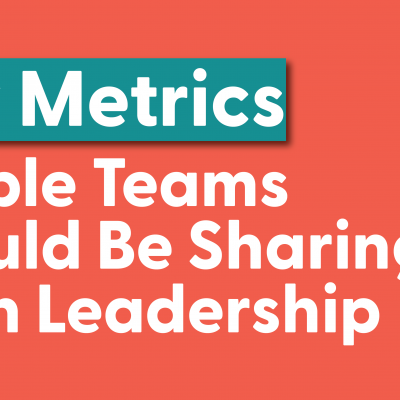Metrics aren’t always the most exciting part of being in People Ops, but the cold hard truth is that metrics are the secret weapon to ensuring your team has a respected voice within your organization. Clearly conveying the metrics that matter to leadership can help prove that you’re data-driven, accountable, always seeking improvement, a strong communicator, and perhaps most importantly that you provide real value to your organization.
The metrics that specific leaders care about may vary, or shift over time with macroeconomic climates, but identifying them now can set your department up for success as one they can trust to improve the health and output of your organization.
Metrics will always matter, so let’s break down the ones you should be sharing with your leaders.
Retention rate
Retention rate, which effectively measures the percentage of employees who remain with your organization over a certain period of time, is a critical metric for any organization. It can have a major impact on employee morale, customer satisfaction, the timeline for deliverables, organizational expertise, and perhaps most importantly to leadership, it can impact the budget.
Average retention rates can vary wildly depending on the industry (Leisure and Hospitality – 84%, Federal Government – 18%), so when determining your own retention rate, make sure you’re comparing apples to apples so you have a more accurate understanding of how you’re doing.
The cost to replace an employee can range from 1.5-2x of that employee’s salary, so the bottom line impact on retention will be massively important for you to share as well. By sharing this metric you’ll be able to clearly define areas of improvement that you can leverage for more budget, or highlight areas of success so you can build trust and leverage for more budget.
Employee engagement
It’s not a secret that a high level of employee engagement can result in higher productivity and better performance, leading to better business outcomes. What might be an inadvertent secret to leadership is the actual employee engagement of their employee population.
Surveying employees regularly (but not “too” often) is a great way to keep a pulse on the engagement and satisfaction levels of employees across the organization. In turn, People Teams will be the source of accurate data as it pertains to company morale and motivation. By being the experts on the engagement level of your people, you can provide leadership with the information they need to shift course if necessary, or again, heap praise on the amazing work you and your team are doing.
The time and cost to fill positions
These metrics go hand-in-hand with retention rate, because if you can’t keep the people you hire, the time in which it takes to fill the vacant positions and the cost associated with finding the talent can be significant.
Provide your leadership with metrics on how long it currently takes to fill an opening in your organization and then the time required to onboard that new employee. Even if your metrics aren’t painting a positive picture, by demonstrating how a lengthy hiring process can result in lost productivity, revenue, and increased costs associated with recruiting (ads, headhunter fees etc…) and training new hires, you’re helping leadership by shining a light on an area that might need more funding and support.
In this case, communicating these metrics has an added benefit as they also underscore the costly importance of employee retention.
Leave of absence requests and turnover
Another critical metric to share with leadership is the amount of leave of absence requests your team is having to manage. An uptick in leave requests could simply be due to an uptick in headcount, but even organizations with steady personnel are seeing an increase. This is due to many factors, but could be an indication that your employees are overworked or over-stressed, and could lead to burnout and increased turnover.
This issue can compound itself if your team isn’t equipped to empathetically and efficiently handle leaves of absence, because not only are employees needing a reprieve to take care of life’s biggest moments, but if they aren’t supported through that journey they’re more likely to look elsewhere.
If when an employee takes a leave of absence the metrics are telling you there is an increased risk of them not returning to work, you can now bring this to the attention of leadership to address the trouble spot and improve your organization’s performance around leave management.
High absenteeism and turnover can signal low employee morale or dissatisfaction with the organization and metrics around both can help to provide leadership with a comprehensive understanding of employee satisfaction and engagement.
Be a metrics maven
By providing the right metrics to leadership you’re demonstrating that the decisions you make on behalf of the company and your employee base are driven by evidence specific to your organization that you can compare to industry averages.
Doing so allows you to shine a light on your improvements and successes, and gives you the authority to work alongside leadership and take corrective action to improve organizational performance and employee satisfaction, while demonstrating the tremendous value you and your People Team provide.
About Tilt
Tilt is leading the charge in all things leave of absence management through easy-to-use tech and human touch. Since 2017, our proprietary platform and Empathy Warriors have been helping customers make leave not suck by eliminating administrative burdens, keeping companies compliant, and providing a truly positive and supportive leave of absence experience for their people.







